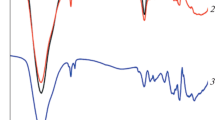Abstract
Biopolymer blend materials of PLLA/PHB/TBC/MWCNT have been prepared by solvent casting and then melted to form films. The electrical conductivity, thermal properties, crystal structure, and morphology of new blends were studied. The AC conductivity is still constant in the case of low frequency or high frequency, and is increased with rising temperature like semiconductor materials and the conductivity of the blends can be increased from 10−17 S cm−1 (pure PLLA) to 10−1 S cm−1 (blend 5). It is observable that the dielectric loss (ε″) is improved after adding MWCNT to PLLA matrix and its values reach 1013 which decrease as frequency increase to 104 in comparing the blend of PLLA/PHB/TBC as the reference without MWCNT. Thermal behavior and crystalline behavior were investigated by DSC. The lower Tg decreased from 60 °C for pure PLLA to 20 °C for the blend 5 due to an active interaction between all components. WAXD found the existing peak at 2 ϑ = 25° and 44° for MWCNT. The good interface structure between the MWCNT and PLLA was examined by TEM. It is found the dispersion of MWCNT in the PLLA matrix uniformly, no aggregation; therefore, the electrical conductivity increased.








Similar content being viewed by others
References
L. Vaccarini, G. Désarmot, R. Almairac et al., Reinforcement of an epoxy resin by single walled nanotubes. AIP Conference Proceedings 544, 521 (2000)
D. Gabriel, A. Karbach, D. Drechsler et al., Bound rubber morphology and loss tangent properties of carbon-black-filled rubber compounds. Colloid Polym. Sci. 294(3), 501–511 (2016)
K.-T. Hsiao, J. Alms, S.G. Advani, Use of epoxy/multiwalled carbon nanotubes as adhesives to join graphite fibre reinforced polymer composites. Nanotechnology 14(7), 791–793 (2003)
J. Hopewell, R. Dvorak, E. Kosior et al., Plastics recycling: challenges and opportunities. Phil. Trans. R. Soc. B 364, 2115–2126 (2009)
P.J. Brigandi, M.J. Cogen, R.A. Pearson, Electrically conductive multiphase polymer blend carbon-based composites. Polym. Eng. Sci. 54(1), 1–15 (2014)
C. Lu, X.N. Hu et al., Triple percolation behavior and positive temperature coefficient effect of conductive polymer composites with especial interface morphology. Polym. Bull. 68(7), 2071–2087 (2012)
T. Ramanathan, A.A. Abdala, S. Stankovich et al., Functionalized graphene sheets for polymer nanocomposites. Nat. Nanotechnol. 3(6), 327–3231 (2008)
M.E. Achour, C. Brosseau, F. Carmona, Dielectric relaxation in carbon black-epoxy composite materials. J. Appl. Phys. 103, 094103 (2008)
S. Zhou, Y. Chen, H. Zou et al., Thermally conductive composites obtained by flake graphite filling immiscible Polyamide 6/Polycarbonate blends. Thermochim. Acta 566, 84–91 (2013)
G. Chen, W. Weng, D. Wu et al., PMMA/graphite nanosheets composite and its conducting properties. Eur. Polymer J. 39(12), 2329–2335 (2003)
H. Kim, A. Abdala, C.W. Macosko, Graphene/polymer nanocomposites. Macromolecules 43(11), 6515–6530 (2010)
S. Stankovich, D.A. Dikin, R.D. Piner et al., Synthesis of graphene-based nanosheets via chemical reduction of exfoliated graphite oxide. Carbon 45(7), 1558–1565 (2007)
H.B. Zhang, W.G. Zheng, Q. Yan et al., Electrically conductive polyethylene terephthalate/graphene nanocomposites prepared by melt compounding. Polymer 51(5), 1191–1196 (2010)
G.H. Chen, J.G. Lu, D.J. Wu, The electrical properties of graphite nanosheet filled immiscible polymer blends. Mater Chem Phys 104(2–3), 240–243 (2007)
Z.M. Dang, L. Wang, Y. Yin et al., Giant dielectric permittivities in functionalized carbon-nanotube/electroactive-polymer nanocomposites. Adv. Mater. 19(6), 852–857 (2007)
ZM Dang, JP Wu, HP Xu, et al., Dielectric properties of upright carbon fiber filled poly(vinylidene fluoride) composite with low percolation threshold and weak temperature dependence. Appl. Phys. Lett. 91, 212901 2007.
J. Li, P.C. Ma, W.S. Chow et al., Correlations between percolation threshold, dispersion state, and aspect ratio of carbon nanotubes. Adv. Funct. Mater. 17(16), 3207–3215 (2007)
P. Poetschke, S. Pegel, M.Claes, et al., A novel strategy to incorporate carbon nanotubes into thermoplastic matrices. Macromol. Rapid. Commun. 29(3), 244–251 (2008)
M.V. Fabretto, D.R. Evans, M. Mueller et al., Polymeric material with metal-like conductivity for next generation organic electronic devices. Chem. Mater. 24(20), 3998–4003 (2012)
F.C. Lavarda, M.C. dos Santos, D.S. Galvão et al., Insulator-to-metal transition in polythiophene. Phys. Rev. B, 49(2), 979–983 (1994)
A.J. Heeger, Semiconducting and metallic polymers: the fourth generation of polymeric materials (Nobel Lecture). Angew. Chem. Int. Edit. 40(14), 2591–2611 (2001)
M. Sumita, K. Sakata, S. Asai et al., Dispersion of fillers and the electrical conductivity of polymer blends filled with carbon black. Polym. Bull. 25(2), 265–271 (1991)
H. Kong, C. Gao, D.J. Yan, Controlled functionalization of multiwalled carbon nanotubes by in situ. Atom transfer radical polymerization. Am. Chem. Soc. 126(2), 412–414 (2004)
C. Park, Z. Ounaies, K.A. Watson et al., Dispersion of single wall carbon nanotubes by in situ polymerization under sonication. Chem. Phys. Lett. 364(3–4), 303–309 (2002)
N. Grossiord, J. Loos, O. Regev et al., Toolbox for dispersing carbon nanotubes into polymers to get conductive nanocomposites. Chem. Mater. 18, 1089–1099 (2006)
M. Lai, J. Li, J. Yang et al., The morphology and thermal properties of multi-walled carbon nanotube and poly(hydroxybutyrate-co-hydroxyvalerate) composite. Polym. Int. 53(10), 1479–1484 (2004)
C. Yang, Y. Lin, C.W., et al., Modified carbon nanotube composites with high dielectric constant low dielectric loss and large energy density. Carbon 47(4), 1096–1104 (2009)
F. Kremer, A. Schoenhals. Broadband dielectric spectroscopy. https://doi.org/10.1007/978-3-642-56120-7, ISBN 978-3-642-56120-7 (Springer, Berlin, 2003)
A. El-hadi, Increase the elongation at break of poly (lactic acid) composites for use in food packaging films. Sci. Rep. 7, 46767 (2017)
A. El-hadi, Development of novel biopolymer blends based on poly(l-lactic acid), poly((R)-3-hydroxybutyrate), and plasticizer. Poly. Eng. and Sci. 54(6), 1394–1402 (2014)
S.K. Misra, F. Ohashi, S.P. Valappil et al., Characterization of carbon nanotube (MWCNT) containing P (3HB)/bioactive glass composites for tissue engineering applications. Acta Biomater 6, 735–742 (2010)
S.G. Bachhav, D.R. Patil, Synthesis and characterization of polyaniline-multiwalled carbon nanotube nanocomposites and its electrical percolation behavior. Am J Mater Sci 5, 90–95 (2015)
Author information
Authors and Affiliations
Corresponding author
Ethics declarations
Conflict of interest
The author declares no conflict of interest.
Rights and permissions
About this article
Cite this article
El-hadi, A.M. Biopolymer blend with semiconductivity for next generation in electronic devices. Appl. Phys. A 124, 445 (2018). https://doi.org/10.1007/s00339-018-1846-4
Received:
Accepted:
Published:
DOI: https://doi.org/10.1007/s00339-018-1846-4




